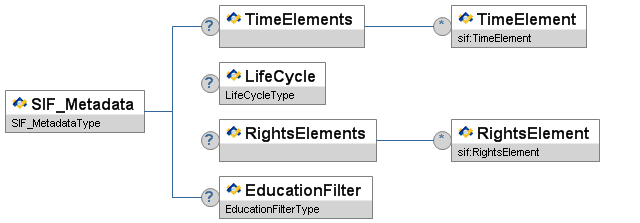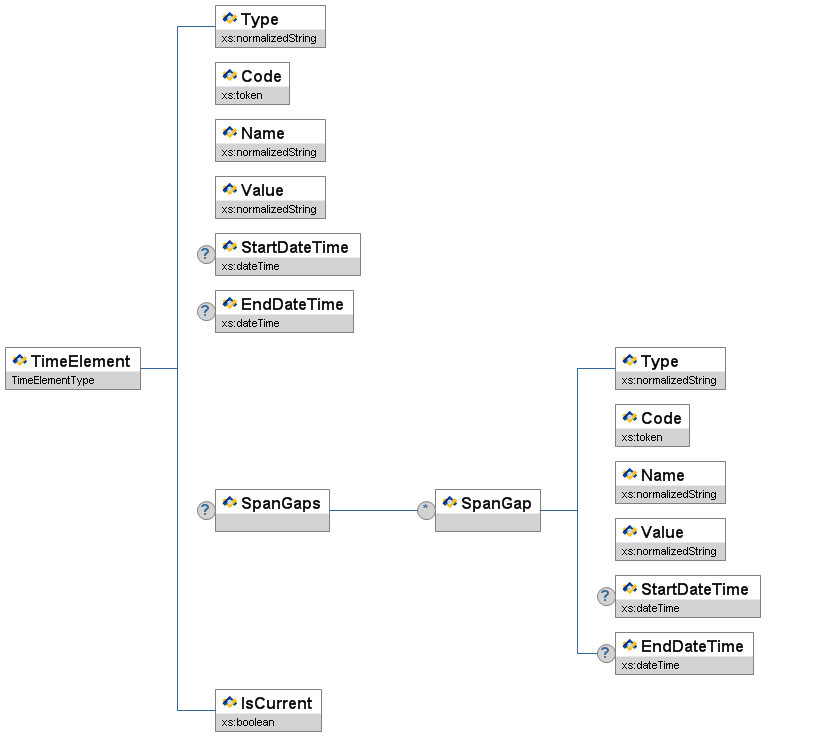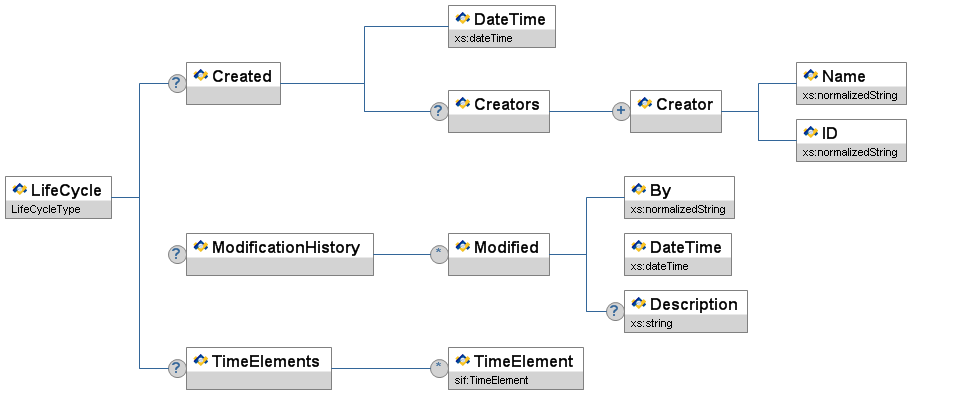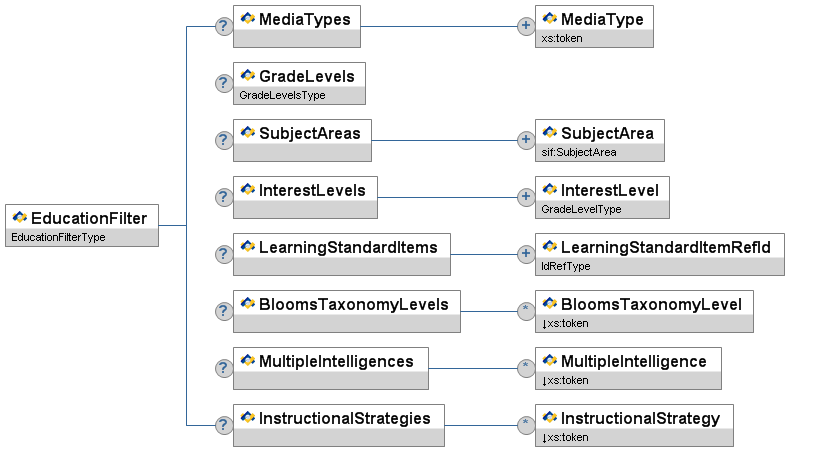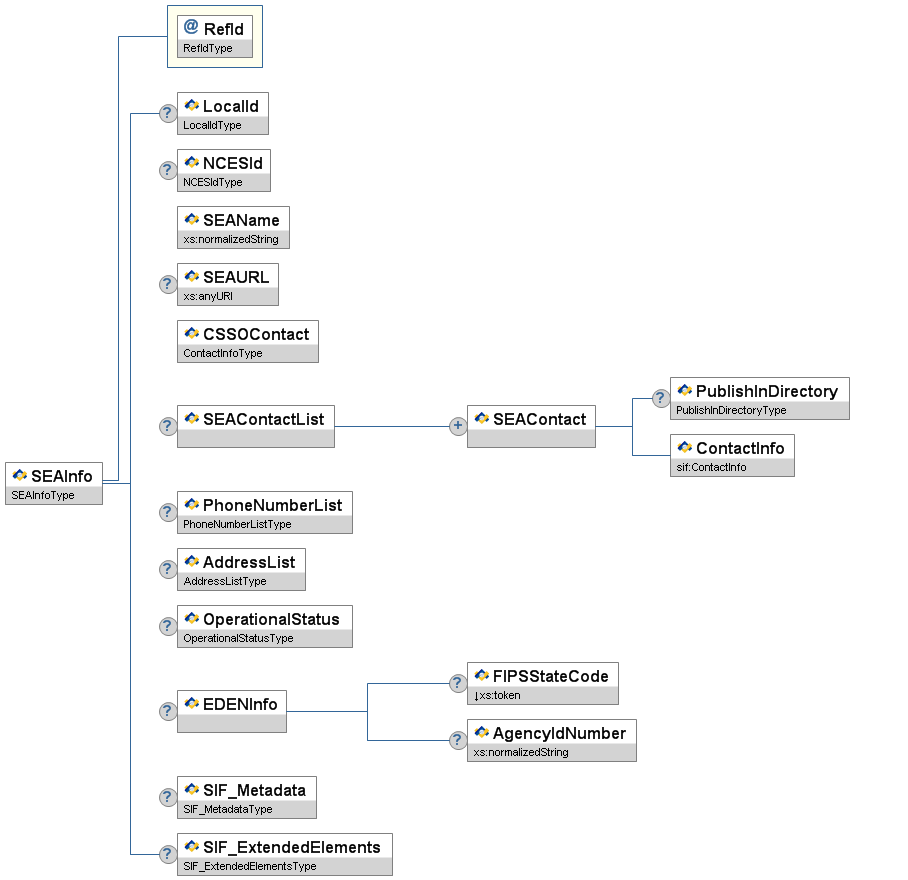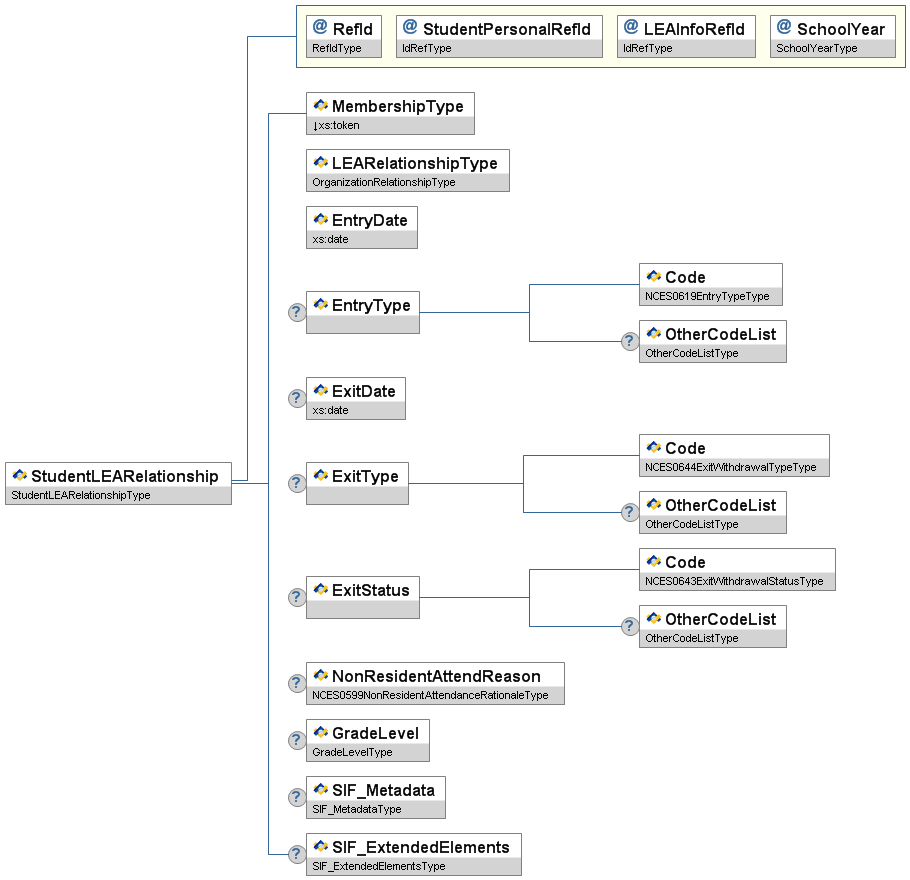6.4 Data Model Task Force
Click here for non-normative background/supplementary documentation from this group.
6.4.1 SIF_Metadata
Metadata is commonly referred to as data about data and includes information such as author, grade level, or keywords relating to a learning object, as examples.
Metadata can be used to structure and contain any of this kind of information in a consistent manner.
In the context of SIF, SIF_Metadata provides a consistent structure to appropriate SIF objects for the purpose of cataloging and object discovery,
as well as other metadata functions and purposes. One recurring use case within the SIF data model is the requirement for some form of temporal constraints and tagging
on objects (see TimeElement). Other metadata elements are based on needs brought to the Data Model Task Force.
IMPORTANT NOTE ON PERSISTENCE
This data is not designed to be permanent.
It is designed to frame an object instance and could dissolve as soon as it leaves the SIF framework for the application space.
A data warehouse could be used to store metadata for later tracking.
IMPORTANT NOTE ON USAGE
Any usage of metadata is optional unless made a requirement
within individual SIF objects, or if a SIF or local profile or zone installation mandates it. SIF_Metadata allows for the usage of metadata in agents and applications that choose to support it.
This element is designed to operate much like SIF_ExtendedElements. It is an approved common element that is part of any data object.
Figure 6.4.1-1: SIF_Metadata| | Element/@Attribute | Char | Description | Type |
|---|
| | SIF_Metadata | | A commonly defined container for metadata elements defined within SIF. | |
| | TimeElements | O | | List |
| | TimeElements/TimeElement | OR | | TimeElement |
| | LifeCycle | O | | LifeCycle |
| | RightsElements | O | | List |
| | RightsElements/RightsElement
| OR | | RightsElement |
| | EducationFilter | O | | EducationFilter |
Table 6.4.1-1: SIF_Metadata
<SIF_Metadata>
<TimeElements>
<TimeElement>
<Type>Full school year</Type>
<Code>01</Code>
<Name>2004/2005 School Year</Name>
<Value>2004-2005</Value>
<StartDateTime>2004-09-01T08:00:00-05:00</StartDateTime>
<EndDateTime>2005-06-30T15:00:00-05:00</EndDateTime>
<SpanGaps>
<SpanGap>
<Type>Holiday</Type>
<Code>02</Code>
<Name>2005 Winter Break</Name>
<Value>2005 Winter Break</Value>
<StartDateTime>2005-02-21T15:00:00-05:00</StartDateTime>
<EndDateTime>2005-02-25T08:00:00-05:00</EndDateTime>
</SpanGap>
</SpanGaps>
<IsCurrent>true</IsCurrent>
</TimeElement>
</TimeElements>
</SIF_Metadata>
6.4.2 TimeElement
A common metadata element designed to contain time data, both self-defined and by type.
Figure 6.4.2-1: TimeElement| | Element/@Attribute | Char | Description | Type |
|---|
| | TimeElement | | A common metadata element designed to contain time data, both self-defined and by type. | |
| | Type | M |
This element is designed to contain the time period attached to an object.
Very long periods (school year, quarter, etc.) and very small periods (second, millisecond, etc.) can be defined.
This element provides a scoping description of the time metadata enclosed.
Because the educational environment varies so greatly we are including here a suggested but not prescriptive list of values.
Although there may be unique needs for values not covered here—and we may have missed a major one—a best practice would be
to utilize the examples here to enhance interoperability.
Examples
Full school year
Mini-term
Long session
Other
Semester
Trimester
Quarter
Spring Vacation
Summer Term
Intercession
Holiday
| xs:normalizedString |
| | Code | M |
This element provides a place for the application to send structured data (code values, unique identifier, timestamps).
This code value can, depending upon the use case agreement between agents, be used to qualify the data in the Value element.
Examples
2007SY
2006.FallConferences
| xs:token |
| | Name | M |
Contains a human-readable description of the value in Value.
Examples
Class of '07
Fall 2007 Parent-Teacher Conferences
| xs:normalizedString |
| | Value | M | Contains the human-readable value. Examples
2007
Evening of 10/12/06
| xs:normalizedString |
| | StartDateTime | O | | xs:dateTime |
| | EndDateTime | O | | xs:dateTime |
| | SpanGaps | O | A container element for holding multiple possible span gaps. | List |
| | SpanGaps/SpanGap | OR |
This structure duplicates much of the structure of TimeElement and is designed to represent a gap in the parent time period
defined by StartDateTime and EndDateTime above.
| |
| | SpanGaps/SpanGap/Type | M | | xs:normalizedString |
| | SpanGaps/SpanGap/Code | M | | xs:token |
| | SpanGaps/SpanGap/Name | M | | xs:normalizedString |
| | SpanGaps/SpanGap/Value | M | | xs:normalizedString |
| | SpanGaps/SpanGap/StartDateTime
| O | | xs:dateTime |
| | SpanGaps/SpanGap/EndDateTime
| O | | xs:dateTime |
| | IsCurrent | M |
This element allows for the system to tag an object as being explicitly current.
Although the baseline assumption in SIF is that objects are always current (default value is typically true),
there are use cases when that is not the case.
| xs:boolean |
Table 6.4.2-1: TimeElement
<TimeElement>
<Type>Full school year</Type>
<Code>01</Code>
<Name>2004/2005 School Year</Name>
<Value>2004-2005</Value>
<StartDateTime>2004-09-01T08:00:00-05:00</StartDateTime>
<EndDateTime>2005-06-30T15:00:00-05:00</EndDateTime>
<SpanGaps>
<SpanGap>
<Type>Holiday</Type>
<Code>02</Code>
<Name>2005 Winter Break</Name>
<Value>2005 Winter Break</Value>
<StartDateTime>2005-02-21T15:00:00-05:00</StartDateTime>
<EndDateTime>2005-02-25T08:00:00-05:00</EndDateTime>
</SpanGap>
</SpanGaps>
<IsCurrent>true</IsCurrent>
</TimeElement>
6.4.3 LifeCycle
This common metadata element describes the life cycle of the object it represents, based on the IEEE LOM LifeCycle element [LOM].
Figure 6.4.3-1: LifeCycle| | Element/@Attribute | Char | Description | Type |
|---|
| | LifeCycle | |
This common metadata element describes the life cycle of the object it represents, based on the IEEE LOM LifeCycle element [LOM].
| |
| | Created | O |
When the object was created by whom. This is a more persistent creation date than
the date/time in the object's SIF_Header.
Depending on the use case being implemented, this value could contain the date the data in the object first entered the zone or was actually created.
| |
| | Created/DateTime | M | | xs:dateTime |
| | Created/Creators | O | | List |
| | Created/Creators/Creator | MR | | |
| | Created/Creators/Creator/
Name | M |
Human-readable name of the data's creator. If the object contains system-generated data,
the name should identify the creating service or application.
| xs:normalizedString |
| | Created/Creators/Creator/
ID | M | Unique identifier of the creator. An email address or URI could be used here. | xs:normalizedString |
| | ModificationHistory | O |
An ordered set of Modified elements describing which system modified the data, when
the modification took place, and a brief description of the modification.
| List |
| | ModificationHistory/Modified
| OR | A single modification event. | |
| | ModificationHistory/Modified/
By | M | Identifier of the system or person that modified the data. | xs:normalizedString |
| | ModificationHistory/Modified/
DateTime | M | The date/time the modification occurred. | xs:dateTime |
| | ModificationHistory/Modified/
Description | O | Human readable description of the data modifications. | xs:string |
| | TimeElements | O | | List |
| | TimeElements/TimeElement | OR | | TimeElement |
Table 6.4.3-1: LifeCycle
<LifeCycle>
<Created>
<DateTime>2006-08-13T09:00:00-05:00</DateTime>
<Creators>
<Creator>
<Name>Alphonse Berdonosi</Name>
<ID>http://www.edugeeks.com/aberdonosi</ID>
</Creator>
</Creators>
</Created>
<ModificationHistory>
<Modified>
<By>http://www.edugeeks.com/aberdonosi</By>
<DateTime>2006-08-17T09:30:00-05:00</DateTime>
</Modified>
</ModificationHistory>
</LifeCycle>
6.4.4 RightsElement
A common metadata element designed to carry any intellectual property or copyright information, based on the IEEE LOM Rights element [LOM].
Figure 6.4.4-1: RightsElement| | Element/@Attribute | Char | Description | Type |
|---|
| | RightsElement | |
A common metadata element designed to carry any intellectual property or copyright information, based on the IEEE LOM Rights element [LOM].
| |
| | Cost | O | | xs:boolean |
| | FeesForUse | O | A container for fees for use of the content in the object. | List |
| | FeesForUse/FeeForUse | OR | Description of one fee structure applying to the use of this resource. | |
| | FeesForUse/FeeForUse/UseType
| M |
A description of the fee structure for this resource.
Some resources may be licensed differently depending upon their context.
For example, a content provider might charge one fee structure for resources used in the classroom and a separate fee for those
resources available to parents from home.
| xs:string |
| | FeesForUse/FeeForUse/MeteringType
| M | | xs:token |
| | FeesForUse/FeeForUse/MeteringURL
| O | | xs:anyURI |
| | FeesForUse/FeeForUse/PerUseCharge
| O | | MonetaryAmountType |
| | CopyrightStatement | O | | xs:string |
| | TermsOfUse | O | | xs:string |
Table 6.4.4-1: RightsElement
<RightsElement>
<Cost>true</Cost>
<FeesForUse>
<FeeForUse>
<UseType>UseType</UseType>
<MeteringType>MeteringType</MeteringType>
<MeteringURL>http://www.xmlspy.com</MeteringURL>
<PerUseCharge Currency="USD">1.00</PerUseCharge>
</FeeForUse>
</FeesForUse>
<CopyrightStatement>CopyrightStatement</CopyrightStatement>
<TermsOfUse>TermsOfUse</TermsOfUse>
</RightsElement>
6.4.5 EducationFilter
Based on feedback from publishers, instructional management and system integrator vendors,
EducationFilter was developed to provide the ability to tag objects with metadata that allows for categorization,
sorting, and filtering, to empower teaching and learning SIF usage. There exist two main business cases:
- Content providers receiving a request for learning resources can tag content with applicable filters.
Upon receipt of SIF objects, receiving application can then read the metadata to categorize the content most appropriately.
- When supported by providers, this metadata can then be utilized in queries to more precisely limit the type of content
returned to requesting applications.
The use cases for EducationFilter require a contract and choreography to be understood between both sides of
the transaction as is the case with all SIF_Metadata.
Figure 6.4.5-1: EducationFilter| | Element/@Attribute | Char | Description | Type |
|---|
| | EducationFilter | | | |
| | MediaTypes | O | Allows an object or query to be tagged with MIME types. | List |
| | MediaTypes/MediaType | MR | | xs:token |
| | GradeLevels | O | Applicable grade levels as defined by SIF. | GradeLevels |
| | SubjectAreas | O | This allows subject areas to be associated with an object or query.
Although there could be overlap with LearningStandardItems, it is anticipated
there will be use cases where LearningStandardItem objects may not exist or may not be available, and data may need to be tagged with high-level subject areas. | List |
| | SubjectAreas/SubjectArea | MR | | SubjectArea |
| | InterestLevels | O | InterestLevels is designed to represent the grade level for which the content is created. For example a tenth grader is at a third grade level in Algebra. You would want to present the content at a third grade level, but in a tenth grade context or interest level. | List |
| | InterestLevels/InterestLevel
| MR | | GradeLevel |
| | LearningStandardItems | O | Allows any SIF object to be correlated to learning standards. | List |
| | LearningStandardItems/LearningStandardItemRefId
| MR | | IdRefType |
| | BloomsTaxonomyLevels | O | This is a taxonomy of educational objectives based on three "domains:" Affective, Psychomotor, and Cognitive.
For the purposes of assigning attributes to learning resources, the SIF specification is limited to the cognitive domain, including knowledge, comprehension, application, analysis, synthesis and evaluation.
| List |
| | BloomsTaxonomyLevels/BloomsTaxonomyLevel
| OR | | values:
- Knowledge
- Comprehension
- Application
- Analysis
- Synthesis
- Evaluation
|
| | MultipleIntelligences | O | An educational theory that describes at least eight different kinds of "intelligences." These include linguistic, logical-mathematical, spatial, bodily-kinesthetic, musical intelligence, interpersonal, intrapersonal and naturalist. | List |
| | MultipleIntelligences/MultipleIntelligence
| OR | | values:
- Linguistic
- Logical-Mathematical
- Spatial
- Musical
- Bodily-Kinesthetic
- Interpersonal
- Intrapersonal
- Naturalist
|
| | InstructionalStrategies | O | The various ways that instruction is delivered to achieve learning objectives and concepts. | List |
| | InstructionalStrategies/InstructionalStrategy
| OR | | values:
- Lecture
- Online
- Discussion
- Cooperative Group
- Scenario
- Demonstration/Lab
- Self-study
- Problem-Based Learning
- Project
- Other
|
Table 6.4.5-1: EducationFilter
<EducationFilter>
<MediaTypes>
<MediaType>x-application/pdf</MediaType>
</MediaTypes>
<GradeLevels>
<GradeLevel>
<Code>10</Code>
</GradeLevel>
</GradeLevels>
<SubjectAreas>
<SubjectArea>
<Code>02</Code>
<OtherCodeList>
<OtherCode Codeset="Text">Algebra and Geometry</OtherCode>
</OtherCodeList>
</SubjectArea>
</SubjectAreas>
<InterestLevels>
<InterestLevel>
<Code>03</Code>
</InterestLevel>
</InterestLevels>
<LearningStandardItems>
<LearningStandardItemRefId>502070339FA347B5B123BEF68D118332</LearningStandardItemRefId>
</LearningStandardItems>
<BloomsTaxonomyLevels>
<BloomsTaxonomyLevel>Analysis</BloomsTaxonomyLevel>
</BloomsTaxonomyLevels>
<MultipleIntelligences>
<MultipleIntelligence>Logical-Mathematical</MultipleIntelligence>
</MultipleIntelligences>
<InstructionalStrategies>
<InstructionalStrategy>Self-study</InstructionalStrategy>
</InstructionalStrategies>
</EducationFilter>
6.4.6 SEAInfo
This object is designed to facilitate the transfer of State Education Agency (SEA) directory information to the Department of Education (USED) through the Education Data Exchange Network (EDEN).
SIF_Events are not reported for this object.
Click here for non-normative background/supplementary documentation on this object.
Figure 6.4.6-1: SEAInfo| | Element/@Attribute | Char | Description | Type |
|---|
| | SEAInfo | | This object is designed to facilitate the transfer of State Education Agency (SEA) directory information to the Department of Education (USED) through the Education Data Exchange Network (EDEN). | |
@
 | RefId | M | The GUID of the SEA whose information this is. | RefIdType |
| | LocalId | O | The locally-assigned identifier for this SEA. | LocalId |
| | NCESId | O | The NCES-assigned identifier for this SEA. | NCESId |
| | SEAName | M | The full legally accepted name of the SEA. | xs:normalizedString |
| | SEAURL | O | URL for the SEA. | xs:anyURI |
| | CSSOContact | M | Chief State School Officer contact information. | ContactInfo |
| | SEAContactList | O | Information on contact persons for this SEA. | List |
| | SEAContactList/SEAContact
| MR | Container element for SEA contact information. | |
| | SEAContactList/SEAContact/
PublishInDirectory | O | Indicates whether or not this SEA contact's information should be published in a directory of SEA information. | PublishInDirectory |
| | SEAContactList/SEAContact/
ContactInfo | M | Contact information for a person at the SEA. | ContactInfo |
| | PhoneNumberList | O | The SEA's phone number(s). | PhoneNumberList |
| | AddressList | O | The SEA's address(es). | AddressList |
| | OperationalStatus | O | Operational condition of an SEA. | OperationalStatus |
| | EDENInfo | O | Container element for EDEN-specific information. | |
| | EDENInfo/FIPSStateCode | O | The two-digit Federal Information Processing Standard (FIPS) Code for the State, District of Columbia, and the possessions and freely associated areas of the United States (e.g. Puerto Rico). | xs:token
|
| | EDENInfo/AgencyIdNumber | O | A number used in EDEN to uniquely uniquely identify state agencies. | xs:normalizedString |
| | SIF_Metadata | O | | SIF_Metadata |
| | SIF_ExtendedElements | O | | SIF_ExtendedElements |
Table 6.4.6-1: SEAInfo
<SEAInfo RefId="D3E34B359D75101A8C3D00AA001A1652">
<SEAName>Illinois State Board of Education</SEAName>
<SEAURL>http://www.isbe.net</SEAURL>
<CSSOContact>
<Name Type="08">
<LastName>Geisel</LastName>
<FirstName>Theodore</FirstName>
</Name>
<PositionTitle>Superintendent</PositionTitle>
<EmailList>
<Email Type="Primary">drseuss@isbe.net</Email>
</EmailList>
<PhoneNumberList>
<PhoneNumber Type="0096">
<Number>(312) 555-0102</Number>
</PhoneNumber>
</PhoneNumberList>
</CSSOContact>
<PhoneNumberList>
<PhoneNumber Type="0096">
<Number>5555551234</Number>
</PhoneNumber>
</PhoneNumberList>
<AddressList>
<Address Type="0123">
<Street>
<Line1>1 IBM Plaza</Line1>
<Line2>Suite 2000</Line2>
<StreetNumber>1</StreetNumber>
<StreetName>IBM</StreetName>
<StreetType>Plaza</StreetType>
<ApartmentType>Suite</ApartmentType>
<ApartmentNumber>2000</ApartmentNumber>
</Street>
<City>Chicago</City>
<StateProvince>IL</StateProvince>
<Country>US</Country>
<PostalCode>60611</PostalCode>
</Address>
</AddressList>
<EDENInfo>
<FIPSStateCode>99</FIPSStateCode>
<AgencyIdNumber>01</AgencyIdNumber>
</EDENInfo>
</SEAInfo>
6.4.7 StudentLEARelationship
The purpose of the StudentLEARelationship object is to represent the current information available regarding a single student's
relationship/affiliation to a single LEA for a specific school year as of the time a SIF_Event or SIF_Response is generated
by the system of record. This object is not designed to operate on a historical/longitudinal basis in the default context.
StudentLEARelationship instances must not span multiple school years.
Only one instance of the StudentLEARelationship object with MembershipType=Home may exist for a specific time interval
between EntryDate and ExitDate (inclusive) for a given student, LEA, and school year.
Multiple instances of the StudentLEARelationship object with MembershipType=Concurrent may exist for a specific time
interval between EntryDate and ExitDate (inclusive) for a given student, LEA, and school year.
Multiple instances of StudentLEARelationship will occur for specific or overlapping time intervals if a student has affiliations
with multiple LEA's. This will most likely be detected during aggregate data collection from multiple LEA's.
Since StudentLEARelationship/@RefId and StudentLEARelationship/@StudentPersonalRefId are zone-specific,
external mechanisms (e.g. student locator) would be required to correlate multiple instances of a single student affiliating with multiple LEA's.
SIF_Events are reported for this object.
Figure 6.4.7-1: StudentLEARelationship| | Element/@Attribute | Char | Description | Type |
|---|
| | StudentLEARelationship | | The purpose of the StudentLEARelationship object is to represent the current information available regarding a single student's
relationship/affiliation to a single LEA for a specific school year as of the time a SIF_Event or SIF_Response is generated
by the system of record. This object is not designed to operate on a historical/longitudinal basis in the default context. StudentLEARelationship instances must not span multiple school years.
Only one instance of the StudentLEARelationship object with MembershipType=Home may exist for a specific time interval
between EntryDate and ExitDate (inclusive) for a given student, LEA, and school year. Multiple instances of the StudentLEARelationship object with MembershipType=Concurrent may exist for a specific time
interval between EntryDate and ExitDate (inclusive) for a given student, LEA, and school year. Multiple instances of StudentLEARelationship will occur for specific or overlapping time intervals if a student has affiliations
with multiple LEA's. This will most likely be detected during aggregate data collection from multiple LEA's.
Since StudentLEARelationship/@RefId and StudentLEARelationship/@StudentPersonalRefId are zone-specific,
external mechanisms (e.g. student locator) would be required to correlate multiple instances of a single student affiliating with multiple LEA's. | |
@
 | RefId | M | The unique identifier for a particular affiliation between a student and a LEA. | RefIdType |
| @ | StudentPersonalRefId | M | The SIF RefId of the StudentPersonal object to which this instance of StudentLEARelationship refers. | IdRefType |
| @ | LEAInfoRefId | M | The SIF RefId of the LEAInfo object to which this instance of StudentLEARelationship refers. | IdRefType |
| @ | SchoolYear | M | Contains the SIF school year to which this instance of StudentLEARelationship applies. StudentLEARelationship must not span multiple school years. | SchoolYear |
| | MembershipType | M | The type of this affiliation as it relates to the LEA identified in LEAInfoRefId. | values:
- Home
- The LEA is responsible for reporting the student's membership/child accounting information.
- Concurrent
- The LEA is not the primary reporting unit for the student's membership/child accounting information.
- Summer
- A summer school enrollment, not part of the regular school year.
|
| | LEARelationshipType | M | An instance of the OrganizationRelationshipType common element that describes the details of the student's affiliation with the LEA. | OrganizationRelationshipType |
| | EntryDate | M | The date from when this affiliation is valid. | xs:date |
| | EntryType | O | | |
| | EntryType/Code | M | Code indicating the type of entry for this affiliation. | NCES0619EntryTypeType |
| | EntryType/OtherCodeList | O | | OtherCodeList |
| | ExitDate | C | The last school calendar day (membership day) the student was affiliated with the LEA (inclusive). The conditional characteristic of this element is defined such that if the student has exited the LEA, then ExitDate must have a value. | xs:date |
| | ExitType | O | | |
| | ExitType/Code | M | Code indicating the type of exit for this affiliation. | NCES0644ExitWithdrawalTypeType |
| | ExitType/OtherCodeList | O | | OtherCodeList |
| | ExitStatus | O | | |
| | ExitStatus/Code | M | Code indicating the exit status for this affiliation. | NCES0643ExitWithdrawalStatusType |
| | ExitStatus/OtherCodeList | O | | OtherCodeList |
| | NonResidentAttendReason | C | Indicates the reason that the student has an affiliation with this LEA if the student is a not a resident of the LEA. The conditional characteristic of this element is defined such that if the LEA participating in this affiliation is outside of the student's usual attendance area, as indicated in the LEARelationshipType/ResidencyStatus element, then this element must be reported. | NCES0599NonResidentAttendanceRationaleType |
| | GradeLevel | O | The grade or academic level of the student. | GradeLevel |
| | SIF_Metadata | O | | SIF_Metadata |
| | SIF_ExtendedElements | O | | SIF_ExtendedElements |
Table 6.4.7-1: StudentLEARelationship
<StudentLEARelationship RefId="98C3D3224B35AA75101D00AA201B1652" StudentPersonalRefId="D3E34B359D75101A8C3D00AA001A1652" LEAInfoRefId="D3E34B359D7511AA223D00AA001A165A" SchoolYear="2007">
<MembershipType>Home</MembershipType>
<LEARelationshipType>
<ResidencyStatus>
<Code>1652</Code>
</ResidencyStatus>
<ProvidingInstruction>true</ProvidingInstruction>
<ProvidingServices>true</ProvidingServices>
<FinanciallyResponsible>true</FinanciallyResponsible>
</LEARelationshipType>
<EntryDate>2007-08-15</EntryDate>
<EntryType>
<Code>1838</Code>
</EntryType>
<GradeLevel>
<Code>10</Code>
</GradeLevel>
</StudentLEARelationship>

